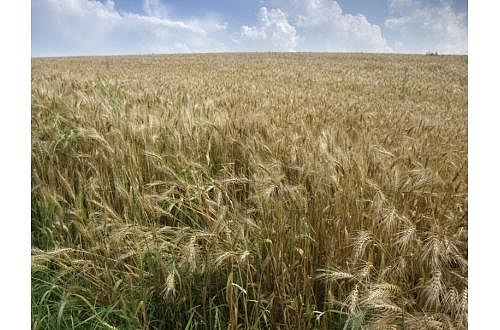Agriculture and food export growth – 29,3%
Photo: Stock.XCHNG
About agriculture, in brief:
• Traditionally, Latvia’s export food products are: alcoholic and non-alcoholic beverages, dairy products,
canned fish and grains;
• Latvia’s grain purchase and processing companies mostly belong to local cooperatives and businessmen;
the largest pig-farming companies are owned by Danes;
• The largest dairy companies – JSC Rīgas Piena kombināts and JSC Valmieras piens – were purchased by Russian investors, establishing the Food Union concern;
• Plant, vegetable and fruit growing constituted the largest share in the agriculture industry’s turnover in 2011 – 65%, followed by livestock and poultry farming – 18%, agricultural equipment and services – 16%, fish farming – 1%. The agriculture industry’s turnover totalled LVL 1,793 billion.
Over the past two years, agricultural and food products have been among the most important Latvian export goods. In 2011, agricultural and food product export amounted to 16,2% of the country’s total export value. In the first half of 2012, the figure increased to 16,7%.
• The industry’s export recorded stable growth in the first half of 2012. Compared to the respective period in 2011, export grew 29,3% or LVL 131,4 million, import – 15,6% or LVL 90 million.
• The industry’s export growth has positively affected Latvia’s agricultural and food product foreign trade balance, which remains negative, but has decreased by LVL 41,5 million. Latvia’s agricultural and food product foreign trade balance was at minus LVL 127,2 million in the first half of 2011.
Traditionally, most important export products:
• non-alcoholic and alcoholic beverages (28% of Latvia’s total agricultural and food product export value),
• milk and dairy products (13%),
• grains (7%).
There was a considerable increase in the value of these products last year. The value of non-alcoholic and alcoholic beverage export grew 43%, milk and dairy products – 20%, grains – 23%.
Largest export share went to EU
• In the first half of 2012, export to the EU grew 31%, the CIS countries – 27%. Overall, export to the EU constituted the largest share – 60%. Lithuania was the most important export destination. 34,9% of Latvia’s agricultural export to the EU went to Lithuania. In 2012, Latvia
successfully continued exporting to 96 third countries. Russia was the most important export destination among them – 72,2% of total export.
Growing market – United Arab Emirates
• In 2012, the largest export increase was registered in the United Arab Emirates. In the first half of 2012, Latvia’s export value to the region amounted to LVL 5 million, compared to LVL 2 million in 2011. Wheat export constituted LVL 3 million. A 164% increase was also recorded in the export value of canned fish. Alcoholic beverage export – sparkling wine, whiskey, vodka, liquor – increased 30% on the previous year.
Most important industry developments:
1. Last year’s grain harvest reached 1,8 million tonnes, 60% more than during the past few years. Grains were sown in the area of 570 000 hectares, 9% more than in 2011. Compared to 2011, the price of grain rose 16% in 2012, soya beans – 34%, increasing producer costs.
2. A land crediting programme was launched, offering LVL 10 million in loans. More than 60 loans worth a total of LVL 3 million were granted within the programme in 2012.
3. The commissioning of LVL 10,4 million worth Latvijas piens dairy processing plant in Jelgava was a major turning point in the industry. The plant belongs to 600 farmers. Its milk reception and pasteurisation capacity is 250 tonnes per shift, cheese production capacity – up to 800 tonnes per month. At the moment, a half of the plant’s production is sold on the local market, another half – exported. In the future, alongside growing demand, the largest share of production will be exported to Germany, Scandinavia and other countries.
4. Pig-breeders experienced a major shock. Due to the Schmallenberg virus, Russia banned hog import from the EU in March 2012. Thus breeders were forced to seek new opportunities mainly in Poland, Lithuania and Estonia. In November, a swine flu outbreak was registered in three farms in Latgale and the affected area expanded up to the Estonian border.
5. Shortly after, 200 cases of the so-called bluetongue disease were confirmed in Latvia and the Food and Veterinary Service placed a temporary ban on cattle export. The ban was lifted at the end of the year, when the European Union’s Reference Laboratory confirmed during additional examination that the virus originated from a vaccine and not a naturally-circulating agent.
6. Milk prices stabilised. They dropped to 11 santims per litre in the first half of 2012, but rose at the end of the year. At the beginning of 2013, milk prices reached 20 santims per litre.
Five largest agricultural companies in terms of net turnover in 2011
Company
| Specialisation
| Turnover 2011, millions, EUR
| Turnover 2010, millions, EUR
| Turnover changes, 2011 vs 2010, %
| Profit 2011, millions, EUR
| Number of employees, 2011*
|
Latraps
| Agricultural services
| 129,80
| 107,56
| 20
| 2,85
| 92
|
Baltic Agro Ltd
| Plant-growing, technical crops
| 73,36
| 59,54
| 23
| 1,84
| 40
|
Agrolats Ltd
| Plant-growing, technical crops
| 70,67
| 47,95
| 47
| 0,89
| 33
|
JSC Balticovo
| Poultry farming
| 33,18
| 30,19
| 10
| 0,64
| 186
|
Scandagra Latvia Ltd
| Agricultural chemistry
| 30,27
| 34,02
| -11
| -0,32
| 17
|
* Average number of employees. Source: Firmas.lv
Useful links
Ministry of Agriculture
Central Statistical Bureau
Latvian Federation of Food Enterprises
Agricultural Market Promotion Centre
Agricultural Data Centre
Rural Support Centre
Food and Veterinary Service





